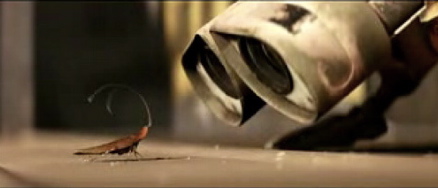
| Home |
| Plot |
| Characters |
| Analysis |
| Reviews |
| Fun Facts |
| Resources & Links |
| Analysis |
 |
“WALL-E” has been both hailed by critics as a visual masterpiece and a piece of substantive social commentary. The movie comments on environmental destruction, the dangers of big corporations, and the changing modes of human interaction and life, as well as the consequences of these changes. As stated in the summary, one of the first scenes the audience witnesses is a desolate, polluted Earth. While it is unclear as to how the Earth got so polluted, it is clear that it forced humanity to leave to space. Some might say this is one of the main messages of the movie, but director Andrew Stanton actually did not mean for it to be. He said, on the subject of the environmental message of the movie, “Everything I wanted to do was based on the film's love story, the last robot on Earth, the sentence that we first came up with in 1994. I said, 'I have to get everybody off the planet, and do it in a way that audiences get it without any dialogue.' So trash did that.” If anything else, the critical response to an assumed environmental message might provide more social commentary than the actual depiction of Earth as an uninhabitable dump. The Buy ‘n Large corporation is one of the main cultural influences in the movie. From cleaning up the Earth to owning superstores to launching humanity into space, the Buy ‘n Large company is involved in every aspect of life. The portrayal of the CEO, Shelby Forthwright, as an intrusive, dominant force in society can be interpreted as a warning to the effects that an overly capitalistic, consumerist based society can have on our lives. The real beauty of the movie, however, is the love story between WALL-E and E VE. In this modern society, human beings are shown to have shallow, electronic based communications with each other. They are obese, lazy, and have trouble thinking for themselves or participating in novel activities. The two human beings that interact outside of the control of technology, John and Mary, only do so after having been literally shook into sense by the collision of their hover chairs. Human beings’ overly complicated, superficial lives are contrasted beautifully by the WALL-E’s life on Earth, as depicted in the first third of the film. This section is dialogue free, but is by far the deepest part of the movie. WALL-E’s very Chaplinesque performance gives the viewers comical relief through his quirky, awkward behavior, and informs viewers of the loneliness of his life and his desire for a connection with another being out that of his pet cockroach. Once WALL-E lays his eyes, or better yet his goggles, on EVE, he becomes nervous, scared, apprehensive, and infatuated all at the same time, a strikingly human response. His courtship rings eerily and comically true, and his dedication once his “plant” is inside of EVE is nothing short of that a husband would show towards his wife. As Washington Post reviewer John Anderston states, “What Uncle Walt and Disney once did for wildlife Pixar does for inanimate/animate objects. Via the anthropomorphic gesture and the vocal endearment, the characters in "WALL·E" are made more human than the humans.” I cannot agree with this more. WALL-E, through his quest for true happiness strikes us as more human than the actual human beings, who pursue material happiness. |
Created by Nathan Cummins, a student at DePauw University. If you have any questions, comments, or just want to gab, please email me
Created on December 2nd, 2008. Updated December 3rd, 2008.